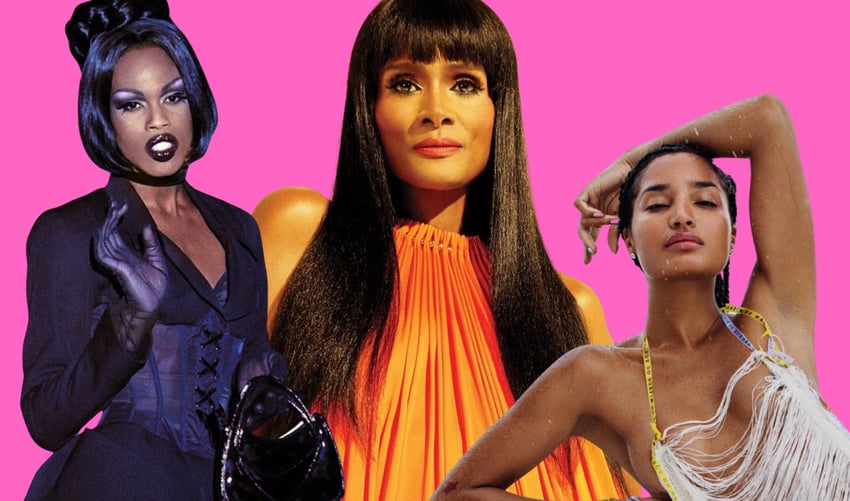Invisible ICONS
Black Trans Women have broken down MANY barriers in the Fashion Industry. So why are they STILL absent on most major runways?...
3/12/20253 min read


In recent years, the trans community has dramatically reshaped the fashion industry, challenging conventional norms and inspiring creativity. Runways have seen groundbreaking talents like Alex Consani, Valentina Sampaio, Dalton Dubois, and Colin Jones take center stage, yet an unsettling truth remains: black and brown trans women continue to be sidelined when it comes to castings, collaborations, and influencer opportunities.
A Glaring Disparity on the Runway
While white trans models are frequently celebrated for their boundary-pushing looks and narratives, the stark underrepresentation of black and brown trans women is impossible to ignore. Connie Fleming, for example, remains one of the few visible black trans models consistently cast in major shows. Meanwhile, Laverne Cox stands as the solitary black trans woman prominently featured in mainstream fashion media—a reality that many in the community find both absurd and unacceptable. This limited visibility not only distorts the true spectrum of trans talent but also perpetuates an industry bias that marginalizes voices of color.
The Unseen Talent
Beyond the few names that break through the barrier, a wealth of black and POC trans talent is crying out for recognition. There are countless emerging designers, models, and influencers whose work reflects a deep, nuanced understanding of their cultural heritage and lived experiences. These artists bring perspectives that can enrich fashion storytelling, yet they are routinely overlooked in favor of more marketable, mainstream faces.
Industry gatekeepers need to expand their vision and embrace diversity by casting a wider net. More inclusive practices—ranging from runway castings to high-profile collaborations—are essential for ensuring that the beauty and innovation of black and brown trans women receive the recognition they deserve.
The Legacy
Long before white trans models began capturing the spotlight, influential figures like Tracey Africa, Leyna Bloom, Isis King, Lea T, and Indya Moore were already rewriting the rules of beauty and breaking barriers in the fashion industry. These trailblazers not only redefined traditional aesthetics but also forged a path for future generations, proving that true style knows no bounds.
Tracey Africa emerged as a pioneering force at a time when trans representation was scarce, challenging norms with her bold presence and setting a foundation for others to follow. Leyna Bloom has since captivated audiences with her unapologetic celebration of diversity, becoming a symbol of empowerment and inspiring designers to rethink conventional casting. Isis King shattered expectations as the first transgender contestant on mainstream platforms, demonstrating that trans beauty and talent deserve recognition on every stage.
Lea T’s groundbreaking career in high fashion—marked by her work with top designers and luxury brands—has transformed industry standards and opened doors for trans models across the board. Indya Moore, known both for their dynamic runway presence and their impactful role on screen, continues to champion trans visibility while using their platform to advocate for inclusivity and social change.
These icons not only paved the way for white trans models to step into the limelight but also redefined the narrative around trans identity in fashion. Their legacies serve as a powerful reminder that innovation and excellence come in many forms, inspiring today's designers, photographers, and artists to honor and elevate trans voices. In celebrating their contributions, the industry acknowledges that the progress we see today is built on the courage and creativity of those who dared to challenge the status quo..
A Call for Change
The current state of fashion media and casting practices underscores an urgent need for change. While trans models have undoubtedly opened doors and challenged stereotypes, it is critical to dismantle the existing hierarchy that favors certain aesthetics over genuine diversity. The industry must actively seek out and uplift the voices of black and brown trans women—not just as tokens, but as key contributors to the evolving narrative of modern fashion.
As the fashion world continues to evolve, embracing a more inclusive approach will not only correct long standing inequities but also enrich the cultural fabric of the industry. The time has come for designers, casting directors, and media influencers to recognize that true innovation in fashion comes from celebrating all forms of beauty and identity.
Looking Forward
For a future where the runway truly reflects the multifaceted nature of trans identity, change must start now. By championing underrepresented voices and honoring the legacies of trans icons, the fashion industry can pave the way for a more equitable and vibrant landscape. Embracing the full spectrum of trans talent—especially that of black and brown trans women—is not just a call for justice; it’s an invitation to redefine the very essence of beauty in contemporary fashion.


